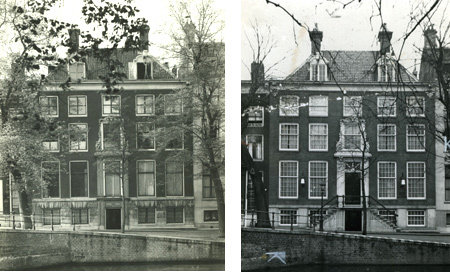Two exhibitions
dal 11/10/2007 al 16/4/2008
Segnalato da
Netherlands Architecture Institute
11/10/2007
Two exhibitions
Netherlands Architecture Institute, Rotterdam
A selection of the resulting extensive collection of "before and after" images. These make it clear how assiduously the architect A.A. Kok tackled the task: some buildings are scarcely recognizable. Visitors can enjoy spotting the changes. In the Gallery 1: Pierre Cuypers, the most comprehensive review of the work of the inspired and controversial architect.

(Gallery 2): 12 october 2007 - 17 february 2008
Still-life
Amsterdam’s ‘girdle’ of semicircular canals – a cityscape celebrated in song, trodden by throngs of tourists. It is a candidate for the World Heritage List and the capital’s most lucrative showpiece. What few people realize is that this famous ensemble is not purely a cherished remnant Holland’s Golden Age. The inner-city canals we now know are partly a carefully composed still-life, constructed in the early years of the twentieth century through restoration activities by Dutch architect A. A. Kok.
Idealized version
The architect A.A. Kok and his son IJsbrand were part of a movement in restoration that aimed to recreate an idealized version of the past. Their restoration of part of the Canal Girdle was based upon their idealized interpretation of the 17th century architecture of the Golden Age. Kok & Son made a thorough job of their restoration work. They rebuilt bell gables on houses that had lost them, added new doors, and replaced large windows by more “antique” ones with small panes of glass.
Spot the changes
Kok had photographs taken of each make-over. The NAI presents a selection of the resulting extensive collection of “before and after” images in Gallery 2. These make it clear how assiduously Kok tackled the task: some buildings are scarcely recognizable. Visitors to the exhibition can enjoy spotting the changes.
---
(Gallery 1) and NAI Maastricht (Column Hall): 22 september 2007 - 06 january 2008
The architect Pierre Cuypers (1827-1921): famed and maligned. He enriched the Dutch landscape with dozens of churches, designed 'Centraal Station' and the 'Rijksmuseum' in Amsterdam, and restored a considerable number of buildings, among them the medieval castle 'Kasteel de Haar' near Utrecht. His architecture and views remain controversial, because he took a standpoint in the debate on the significance of architecture in relation to religion and community - a debate that is still highly topical. The inventory of the largest archive in the Netherlands Architecture Institute's possession has now been completed. From September 22, the NAI will present in both Rotterdam and Maastricht the most comprehensive review ever of the work of this inspired and controversial architect.
Passion for Architecture
Cuypers had a mission: he believed in an ideal of community, in architecture capable of instigating social change, in architecture as a Gesamtkunstwerk and in the Neogothic as the only justifiable architectural style. As befitted his ideals, he harked back to the Middle Ages, to a society of clear-cut ranks and strata with the Catholic Church as its center, and to the craftsmanship tradition of the guilds. The exhibitions in Rotterdam and Maastricht bring Cuypers' passion for architecture to life. Each of the two exhibitions presents a cross-section of Cuypers' life, so placing his ideas, designs and actions within the dynamic of the latter half of the nineteenth century. In Rotterdam, the cross-section covers the year 1877, and in Maastricht the year 1897.
1877 in NAI Rotterdam
Cuypers turned 50 in 1877. That year he was working on the two most widely discussed national buildings of the nineteenth century, Amsterdam's Central Station and the Rijksmuseum. He built and restored churches, upheld an absurdly busy itinerary, headed several workshops and had just been appointed 'Rijksbouwmeester' (Chief Government Architect). He was also under heavy fire from critics during the same period but this did not stand in the way of an impressive output of work in which he held artistic sway over all details. The exhibitions bear witness to Cuypers' mental world and his energy, with dozens of sketches, drawings, books and photographs. Furthermore, a spectacular collection has been assembled of altars, prie-dieux, statuary and other church interior items.
1897 in NAI Maastricht
In 1897, Cuypers reached the age of 70. He was primarily occupied with restoring Kasteel de Haar. The younger generation of architects placed him on a pedestal in this period, seeing him as a pioneer of modern architecture; a greater contrast with 1877 would be hard to picture. The design history of Kasteel de Haar forms the core of the exhibition at NAI Maastricht. In this project, Cuypers aimed to create an idealized, improved version of the original building. The castle became an entirely new Gesamtkunstwerk, and the dazzling array of drawings he also produced made this his best documented project. Kasteel de Haar typifies Cuypers' outlook on restoration, in which he did not eschew adding new construction. Drawings, photographs and a large number of interior items from the castle bear witness to this.
Netherlands Architecture Institute
Museumpark 25
3015 CB Rotterdam Netherlands



